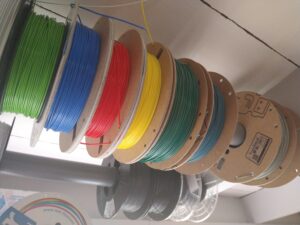Filaments for 3D printing
I often get questions about what filament I use for 3D printing, so I thought it would be nice to write a short article on this subject.
My favorites
I use different brands and types of filament, depending on application and desired quality. PLA is very easy to print and great for prototyping and test prints, while PETG is more robust and can be applied outdoors. I try to buy from dutch companies only, since I live in the Netherlands and there are quite some good filament companies based here.
Real Filament is a rather cheap filament and great for day-to-day printing. It has a nice flow, although sometimes the bed adhesion of their PETG is a bit challenging due to tension in the print (it shrinks just a bit when cooling down). Normally a brim will solve this issue. I do lots of prints with both their PLA and PETG, and in most cases the results are satisfying.
FormFutura has an extensive selection of filaments available. Their HDglass is great to work with, while the PLA results in very clean prints. But yes, it is more expensive; quality comes with a price. Their rPLA however is very cheap and sustainable, since is is made from leftover materials, making it very suitable for testing and prototyping.
Other filaments I’ve tried
I’ve tried some other brands/types too, including these:
- 3DJake ecoPLA: I tested a few colors in 2020, but it didn’t flow very well and caused clogging. I tried lots of settings, but eventually I gave up.
- Innofil3D PLA: nowadays known as BASF Ultrafuse PLA, I tested it in 2018, prints were ok but the colors where a bit dull.
I have been experimenting with some different samples of flexible filament (e.g. FormFutura FlexiFil, Python Flex), but so far without success. The reason for this is most likely because of the bowden extruder; for flexible filaments a direct drive extruder is highly recommended.
I haven’t printed Nylon or ABS, since my printers (Creality CR-10s Pro and CR-20s Pro) are not suitable for this.
Printing temperatures
The table below shows the printing temperatures I use, as well as the price/kilogram I normally pay for it. These temperatures are working for my situation, but heavily depend on the environment. E.g. when you have boxed your printer, you will probably have different results. My printer is in a very small room with is centrally heated and has a temperature of about 20 °C, humidity is mostly below 60% and there is a minimum draft (door is mostly closed when printing). CR-10s Pro stock bed used unless mentioned otherwise.
| Filament | Brand and type | Extruder temp. [°C] | Bed temp.[°C] | ~ Price (€/kg) |
| PETG | FormFutura – HDglass | 240 | 75 | 46 |
| PETG | Real Filament | 230 | 75 | 30 |
| PLA | FormFutura – EasyFil | 215 | 60 | 40 |
| PLA | FormFutura – ReForm rPLA | 215 | 60 | 26 |
| PLA | Real Filament | 205 (First layer 215) | 60 | 25 |
| TPC | FormFutura – FlexiFil | 240 | 100 (direct drive, on glass) | 75 |
| TPE | Real Filament – RealFlex | 200 | 50 | 45 |
![[image]](https://www.pa3hcm.nl/wp-content/uploads/2013/12/enh-logo1.jpg)
